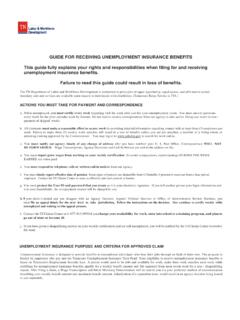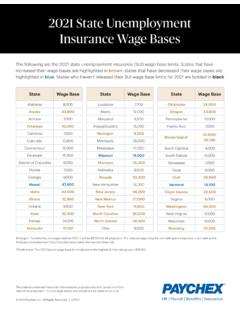Transcription of State Employment and Unemployment - November 2021
1 For release 10:00 (EST) Friday, December 22, 2017 USDL-17-1668 Technical information: Employment : (202) 691-6559 Unemployment : (202) 691-6392 Media contact: (202) 691-5902 State Employment AND Unemployment November 2017 Unemployment rates were lower in November in 8 states, higher in 2 states, and stable in 40 states and the District of Columbia, the Bureau of Labor Statistics reported today. Twenty-three states had jobless rate decreases from a year earlier, 2 states had increases, and 25 states and the District had little or no change.
2 The national Unemployment rate was unchanged from October at percent but was percentage point lower than in November 2016. Nonfarm payroll Employment increased in 6 states in November 2017, decreased in 2 states, and was essentially unchanged in 42 states and the District of Columbia. Over the year, 27 states added nonfarm payroll jobs and 23 states and the District were essentially unchanged. Unemployment Hawaii had the lowest Unemployment rate in November , percent. The rates in Alabama ( percent), California ( percent), Hawaii ( percent), Mississippi ( percent), and Texas ( percent) set new series lows.
3 (All State series begin in 1976.) Alaska had the highest jobless rate, percent. In total, 17 states had Unemployment rates lower than the figure of percent, 9 states and the District of Columbia had higher rates, and 24 states had rates that were not appreciably different from that of the nation. (See tables A and 1 and map 1.) Current Employment Statistics Data for Puerto Rico and the Virgin Islands Response rates for the November 2017 establishment survey were slightly lower than average in Puerto Rico. In addition, a modification was made to the estimation process that accounts for business births and deaths.
4 As of this release, a sufficient amount of establishment data was collected to produce final estimates for October and preliminary estimates for November . The Virgin Islands was not able to administer its establishment survey in September, October, and November . It is unknown at this time when estimates of Employment , hours and earnings will be published for the Virgin Islands. - 2 - More information on the effects of the recent hurricanes on BLS data collection and reporting can be found at In November , eight states had Unemployment rate decreases, the largest of which were in California, Kentucky, Minnesota, and Ohio ( percentage point each).
5 The only over-the-month rate increases occurred in North Carolina (+ percentage point) and North Dakota (+ point). The remaining 40 states and the District of Columbia had jobless rates that were not notably different from those of a month earlier, though some had changes that were at least as large numerically as the significant changes. (See table B.) Twenty-three states had Unemployment rate decreases from November 2016. The largest declines occurred in Alabama and Tennessee ( percentage points and points, respectively). The only over-the-year rate increases were in Alaska and South Dakota (+ percentage point each).
6 (See table C.) Nonfarm Payroll Employment Six states had over-the-month increases in nonfarm payroll Employment in November 2017. The largest increase in Employment over the month occurred in Texas (+54,500), followed by California (+47,400) and New York (+24,900). In percentage terms, the largest increases occurred in Iowa, South Carolina, and Texas (+ percent each). Two states had over-the-month decreases in nonfarm payroll Employment in November : Alaska (-3,000, or percent) and North Dakota (-2,700, or percent). (See tables D and 3.) Twenty-seven states had over-the-year increases in nonfarm payroll Employment in November .
7 The largest job gains occurred in Texas (+330,600), California (+288,300), and Florida (+195,000). The largest percentage gain occurred in Utah (+ percent), followed by Nevada and Texas (+ percent each). (See table E and map 2.) _____ The Metropolitan Area Employment and Unemployment news release for November 2017 is scheduled to be released on Thursday, January 4, 2018, at 10:00 (EST). The State Employment and Unemployment news release for December 2017 is scheduled to be released on Tuesday, January 23, 2018, at 10:00 (EST). Upcoming Changes to Local Area Unemployment Statistics Data Effective with the release of Regional and State Unemployment 2017 Annual Averages on Tuesday, February 27, 2018, the civilian labor force and Unemployment data for the states, the District of Columbia, and the modeled substate areas presented in tables 1 and 2 of this news release will be revised to incorporate updated inputs, new population controls, reestimation of models, and adjustment to new census division and national control totals.
8 In addition, a new procedure for seasonally adjusting the data will be implemented. While the not seasonally adjusted data are subject to revision from 2013 forward, the seasonally adjusted data will be revised back to 1976. Information on the new seasonal adjustment procedure is available at - 3 - Upcoming Changes to Current Employment Statistics Data Effective with the release of January 2018 estimates on March 12, 2018, all nonfarm payroll Employment estimates for states and areas presented in tables 3 and 4 of this news release will be adjusted to 2017 benchmark levels.
9 Also effective with the release of January 2018 estimates, the Current Employment Statistics (CES) program will convert to concurrent seasonal adjustment, which uses all available estimates, including those for the current month, in developing seasonal factors. Currently, the CES program develops seasonal factors once a year during the annual benchmark process. For more information on concurrent seasonal adjustment in the CES State and Area program, see Not seasonally adjusted data beginning with April 2016 and seasonally adjusted data beginning with January 2013 are subject to revision.
10 Some seasonally adjusted series may be revised back to 1990. Conversion to the 2017 North American Industry Classification System With the release of January 2018 data on March 12, 2018, the Current Employment Statistics (CES) survey will revise the basis for industry classification from the 2012 North American Industry Classification System (NAICS) to the 2017 NAICS for all states and metropolitan areas. The conversion to the 2017 NAICS will result in minor revisions reflecting content and coding changes within the retail trade and information sectors. Several industry titles and descriptions also will be updated.

















